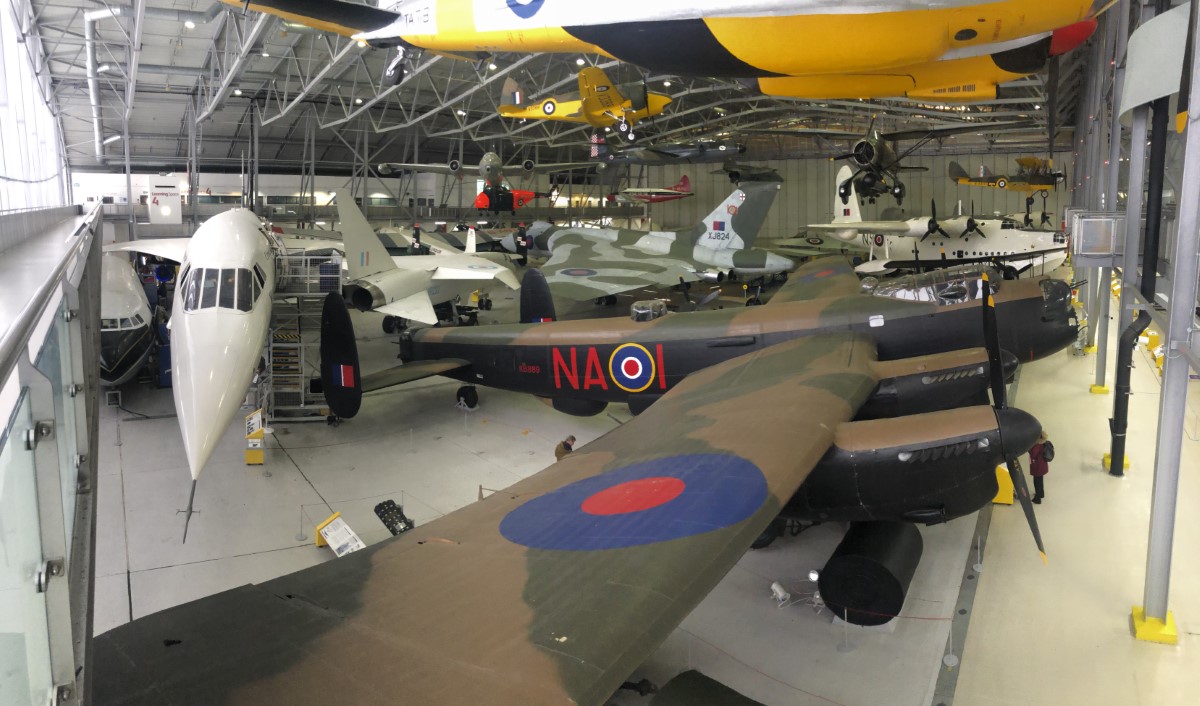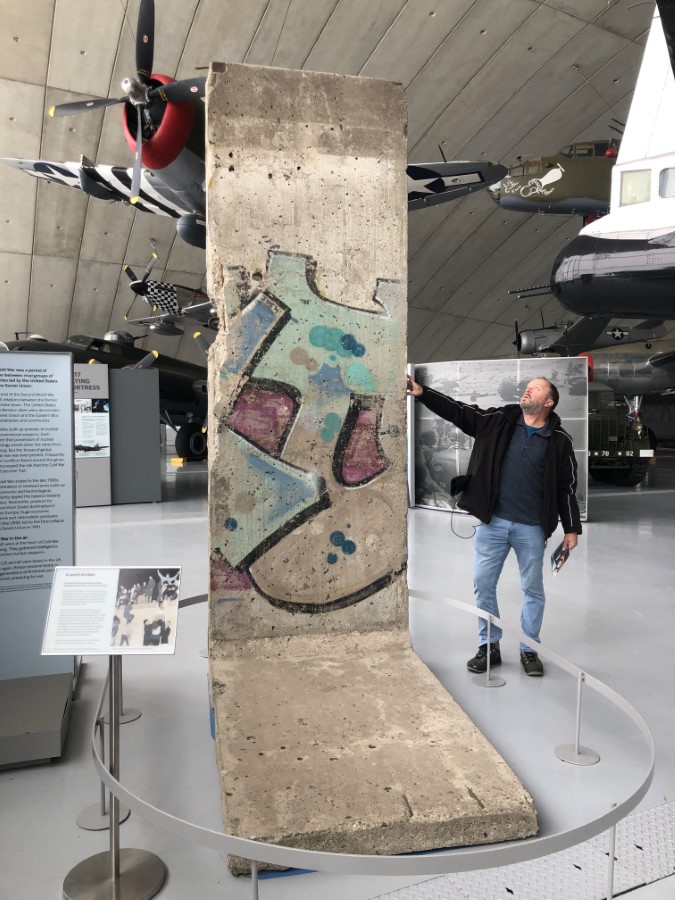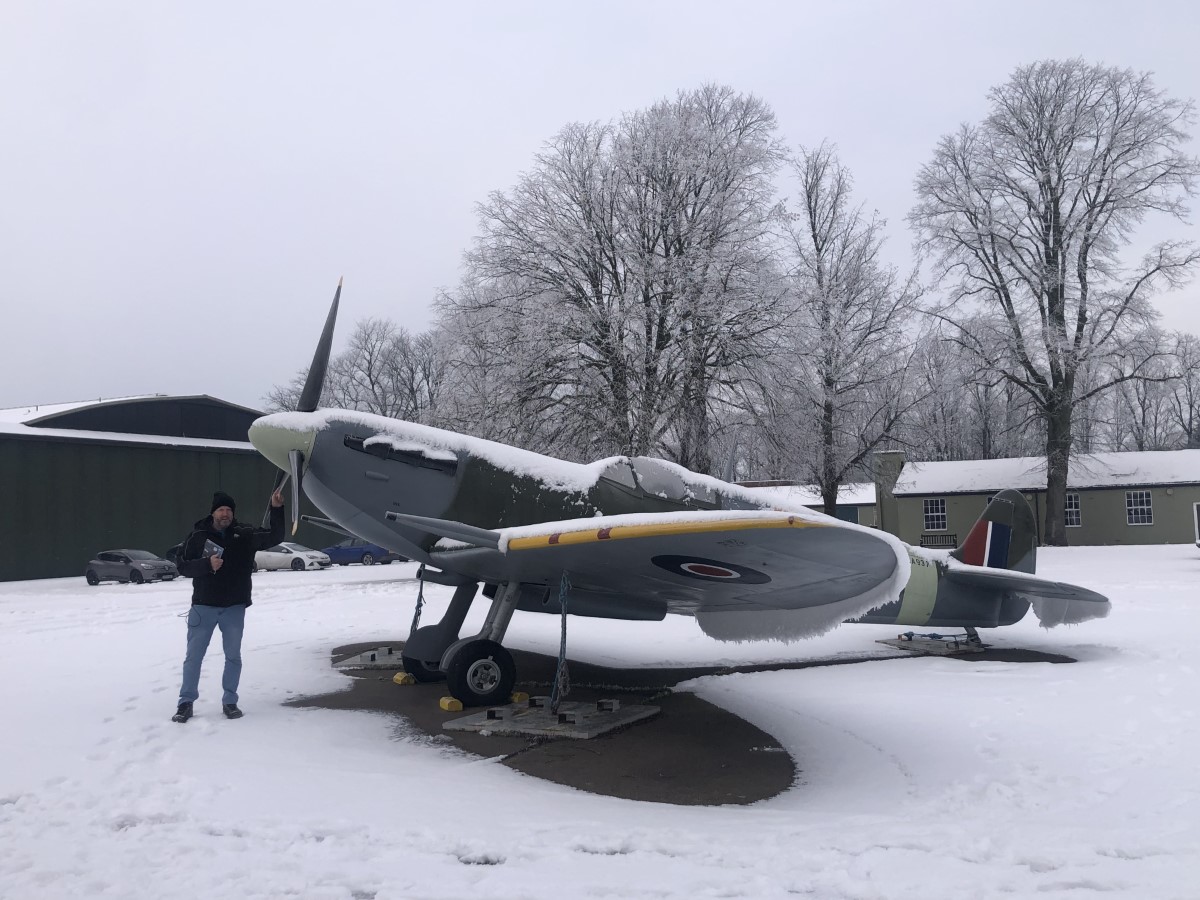But let’s first take a left turn as we enter the grounds and head over to Hanger One, the biggest exhibit.
Hangar One
So, Hangar One is like a sensory overload, when you first walk in. It’s a big hall, but it needs to be. This one is British-themed (obviously) and the first stop on your tour. This rather substantial hall is filled to the gunnels with iconic British aircraft.
British metal
A Short Sunderland parked randomly with a Harrier hovering above it, and a Comet in the corner. A Panavia Tornado or an extremely rare, obscure and politically-charged TSR 2. The fantastic Lightning, the mighty Vulcan and a rather large Lancaster bomber – ready to receive a dam buster bomb.

The best part is being able to get up close to each aeroplane and study it closely. Like counting the rivets on the wings and inspecting the bomb bay of a Vulcan bomber (not many places you can do that!).


A Rolls Royce Pegasus engine and a Trent 800 offer opposing views of jet propulsion; one is used in a single-seat VTOL fighter and the other delivers millions of tourists to Mallorca, Cyprus and other exotic destinations far removed from this white-blanketed chilly part of England.
Sleek white arrow
But your eye is drawn to the far end of the cavernous room. A sleek, white arrow of an aeroplane dominates, not by its size, but by its perfect proportions and undeniable ability.


The Concorde is a technical marvel, shrouded in intrigue aided by its expensive price tag, in both development and ticket cost. The project was birthed in the 1950s and it took to the air in 1969.
This is over fifty years ago – when the height of technology was a slide rule and long division. It showed what could be achieved with a common purpose, the backing of government and a will to succeed.
This one is one of the developmental aeroplanes – the prototype if you will. And yes, you can walk all around it, view it from above and also go inside. It is much longer than you expect and not very large (I can barely stretch my 6’2 frame) but it’s an amazing experience.



Next to it at ground level is an older relic that has no fame at all and I am willing to wager that not many people have heard of a Handley Page Hermes passenger airliner.
Nothing too groundbreaking at all except when you get inside it illustrates how, back in the day, there used to be a crew of five in the cockpit, and there is a rather nice exhibit on how glamorous air travel used to be in the 1950s. Easyjet wasn’t a thing yet.
This is where we meet Graham, a volunteer at the museum and ex-fighter-pilot. He shares his passion and knowledge with great enthusiasm and we spend an enjoyable fifteen minutes chatting with him. We may run into him again later.

There is an ‘Airborne Assault’ section in this hangar as well – which we didn’t visit due to the subliminal time pressure and a long walk to the other side of the aerodrome. Choices to be made. Plan it before you get here is the advice.
SNOWY
Outside four-inch snow carpets the landside and gives the airfield a silent and tranquil air. It is nice and fresh with a hazy sun poking through the clouds and there aren’t many people around at all. Perfect.
There’s a small café with a brew of tea and we opt for a bacon ‘bap’ in order to energize ourselves for the long haul towards the American Air Museum.



What we are served is a pale excuse for a soft white roll, a half-hearted attempt at spreading some butter and an anemically-shaded sliver of bacon. There must be some mistake as it is barely three bites and tastes like the napkin it came in. And to charge £4.50 is beyond a joke.




I have had better efforts served out of a food truck at half the price. I can almost hear them sniggering from the kitchen…
Steer clear of this underwhelming excuse for British culinary greatness, grab your cup of tea and take in the postcard view of the runway and the old passenger liners parked up next to the traffic control tower.
AMERICAN AIR Museum
Norman Foster designed this hangar and, as such, it should not be named a hangar, but rather a museum. It certainly does stand out from the other historical buildings with its domed roof and full-width glass facade facing out to the runway.


You enter from the other side, at cockpit level to an imposing B52. This enormous aircraft dominates the hall, but there are more than twenty iconic military planes here. Hanging from the ceiling or parked busily on the floor.




And that is the overriding impression I get here. It seems as if all the aircraft have been parked haphazardly around the place, perhaps taken in sheltering from the winter weather. Trying to see how many different aeroplanes can be squeezed into one room. The same can be said for Hangar One.


The plane we came to see – the SR71 Blackbird – seems to have been pushed into the nearest available corner before the crew went for lunch, and never came back. It seems a strange place to park one of the icons of aviation.




You can still get right up close to all the aeroplanes, and literally touch them, but – not really knowing what to expect – I feel a little let down by the strange manner of presentation. It may need a few moments to step back and take it all in is what’s needed. There’s a lot going on here…






Land Warfare Hall
This one is located at the far end of the terrain, half a mile from the entrance. It is next to the American Air Museum, so we go in – because we’re here after all, but it is not the main push of our visit.




Ranging from World War One all the way to modern tanks and fighting vehicles it is an impressive display. You can view it all from a raised walkway, and there is also a Normandy-themed area.
Conservation in Action
This hangar is a surprise because one of my favourite aeroplanes is in here. The Shackleton is one of my all-time favourites. I used to build models of it as a kid growing up in South Africa (where the venerable Shackletons were used for Maritime patrol, perfect for the 3000 km long coastline).


This one is in an advanced state of disassembly. Only two engines are on the airframe and the outer wings and engines have been removed. Through the scaffolding, we spy a start made on removing the recognizable white-and-blue colour scheme. It takes up fully one side of the hangar (except for a random Jagdpanther tank hiding in the corner).


On the other side of the hall is quite a substantial collection of engines, a Staghound armoured car and a very tired-looking Argentinian Airforce Pucara next to which are the front sections of a Valiant and Victor.




There was nobody about when we were there but you can imagine the noise of angle grinders, hammering and pneumatic drills. I’m curious as to where they will display the finished Shackleton.


Battle of Britain
This hall is a bit of a misnomer since it doesn’t exactly relate the history of the Battle of Britain but exhibits fighter planes from different time periods from the Spitfires and Hurricanes through to a Meteor, Javelin, Vampire and Hawker Hunter.




This is where we caught up with Graham again and he related his experiences in the Hunter as well as others during his time with the RAF. He first flew this in 1967 and if I do the math it would mean he is well into his seventies – but you wouldn’t know it!



Air and Sea
This one is quite nice since it has some Navy aircraft on display that you don’t normally see, like the strange and complicated Gannet and the Westland Wasp.




Full access was hindered by the two giant airport fire trucks of which the engines were being kept warm (cannot argue with that in a working airport).
An incredibly old double-decker bus was parked here, which may seem slightly incongruous except for the fact that it was pushed into service as a troop carrier during the war. What a lovely old piece.


Flying Aircraft Hall
This hangar is similar in concept to the conservation hangar, but these aircraft are all fully functional, flying examples. It would be good to get back to Duxford for an air show.
There are more serviceable aeroplanes here than you may think. Mostly warbirds like Spitfires, Hawks, Corsairs and a Sea Fury in a severe state of disassembly.




But next door is the big fish like the Catalina and a B17 with Memphis Belle nose art. Hidden in the corner is the Red Baron’s triplane – which is surprisingly small. I would assume it flies as well.


But the most interesting were the rather tall Gladiator and the nimble-looking Hawker Nimrod. Open cowls and removed panels give insight into the complexity of a fighter plane even of inter-war vintage. It was very nice to see the mechanics at work keeping these old birds in the air.
How long to get around?
As alluded to above it is a large open aerodrome and, to visit all the hangars you need to take a stroll. The opening times are from 10 am till four pm. This gives you six hours if you’re there right when the chain comes off the entrance gate.






Is this enough to get around and do everything justice? If you have a particular interest in a certain aeroplane and want to spend some time then you may have to exclude other exhibits. Not a criticism, but an observation with respect to the number of things to see.
What else is there to see?
Facing the runway are a number of older airliners which can be approached and walked under, around and next to. These old birds almost look ready to drop the boarding ladder and take some passengers aboard before taxiing to the runway.
There is an area with a history of women’s involvement during the war. Sadly it was being renovated, so we couldn’t have a look at this lesser-known part of the war effort from Duxford.
A small, incongruous building set between the hangars and the runway does have a story to tell. For those who are looking for some aerodrome history, the interior is set up as it would have been during World War Two, along with a full history of the Duxford Aerodrome throughout the years. Well worth a look.
Is it a museum?
Perhaps the overriding impression I got from the whole day. If you’re looking for a detailed account of the Battle of Britain or the history of aviation in England then Duxford is perhaps not the best place to find this information.
I can imagine it is difficult to put a theme onto a collection of aircraft, especially as varied as these are. Duxford has named itself an Imperial War Museum. This, to me, would indicate a meticulous and elaborate history lesson based on the English war effort and the part played by the aerodrome.






And you will find some of this in the small building mentioned. But the other hangars and buildings don’t carry a common theme except for housing some exceptional hardware. And a Concorde cannot really be seen as a military aircraft, can it?
How much?
At £27.50 entry per person and with half an eye on the overpriced dry bread roll you really need to be an aviation enthusiast.
Some of the aircraft on display are, however, exceptional. Like where else can you get onboard a Concorde? Or how many Blackbirds are kicking about?




Some lesser-known planes are here as well, like the U2, B29, that enormous B52 and a random Warthog. You really can get up very close and examine them in detail, especially the size of some of them. What I particularly enjoyed was the conservation and the flying aircraft hangar. Watching the restoration, preservation and maintenance in progress.
You will get value out of your ticket and a part of the entry fee goes to the aviation heritage. Granted, you do need to arrive armed with information on the aeroplanes on display since there isn’t a great deal of information. But, then again, most of us do and the brief explanations keep us moving on to the next exhibit.


When is the best time to visit? Early December with a dusting of snow is a good shout. You won’t find an airshow, but it looks just magical. And, perhaps most importantly, with only two dozen other people running about we had the run of the place to ourselves!

